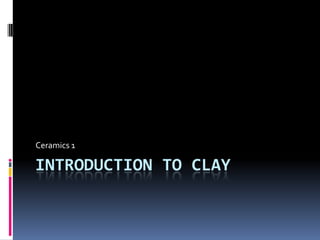
Introduction to clay
- 1. Ceramics 1 INTRODUCTION TO CLAY
- 2. Ceramics Things made from clay, the basic material for all ceramic creations. Clay is created as a result of the decomposition of igneous rock, which makes up the entire earth’s crust. Everything you will do with clay involves the interplay of these 3 variables: Moisture Plasticity Heat
- 3. Origins of Ceramics Of all the arts, ceramics has perhaps the longest history, dating back to when people first learned to control fire. Theories: People first began to model clay as a diversion. People used clay for practical purposes.
- 4. Early Techniques The clay you work with in a studio has been processed and prepared to some degree. Early potters had to actually dig their raw material from the ground and prepare it. There were sometimes impurities that had to be taken out.
- 5. Chapter 2: Working with Clay Clay Properties Plasticity Shrinkage Texture Moisture Handling Clay
- 6. PLASTICITY Most beginners use highly plastic clay, or one that can easily take different shapes. PLASTIC – The property of clay that allows it to change shape without tearing or breaking. Numerous factors can make clay more plastic. You can spray it with water. You can store it in a bag with water. You can mix new plastic clay with the old.
- 7. SHRINKAGE All clay shrinks as they dry. Clay can crack when it shrinks if the potter doesn’t carefully monitor the drying process. It is frustrating the spend a lot of time on creating your artwork only to have it crack because you did not take the time to allow it to dry slowly.
- 8. TEXTURE The texture of a clay body can range from coarse to smooth. Some potters add sand or grog to change the texture of their clay.
- 9. MOISTURE All clay contains water. You can add water to clay to make it more workable or plastic. Add too much water, however, and the clay loses plasticity – it won’t hold any shape at all. Clay begins to dehydrate, or lose moisture, when it is exposed to air. You will occasionally need to rehydrate, or put water back into the clay, to keep it moist.
- 10. MOISTURE You can mist it with a spray bottle or dampen it with a wet sponge or damp paper towel. Once the clay is fired, it becomes permanently harder, stronger, and less likely to break. It can never become plastic again after being fired.
- 11. PREPARING THE CLAY Before you can make anything with clay, you’ll need to prepare it. All clay needs to be de-aired before you begin. Kneading or Wedging eliminates air bubbles and keeps the internal structure of clay more cohesive and consistent.
- 12. Kneading / Wedging Clay You will use a piece of canvas to absorb extra moisture. Since we are using a small amount of clay, we will use the kneading method.
- 13. Clay Safety Tips Little bits of clay that end upon the surface of your table are harmless. However, when they are brushed onto the floor these crumbles break down into smaller and smaller particles which then scatter into the air you breathe. CAPTURE CLAY DUST WITH WATER. Use a wet sponge to clean tables, tools, wheels, and sinks. Brooms and brushes only make more dust.
- 14. SLIP A fluid suspension of clay in water used in joining clay pieces and for surface decoration. It has the consistency of yogurt. You can put your scrap pieces in your slip cup.
- 15. STAGES OF CLAY Plastic Leather-hard Greenware / Bone Dry Bisqueware Glazeware
- 16. PLASTIC CLAY Clay is pliable and plastic. It is somewhat forgiving at this stage. It is at the “workable” consistency for slabs, coils, and throwing. Ware can be reclaimed at this stage.
- 17. LEATHER-HARD CLAY Clay is drier than plastic/workable clay but is somewhat stiffer. Clay has the consistency of a chocolate bar. Pots are incised and trimmed at this stage. Clay is still cool to touch and slightly darker. Ware can be claimed at this stage.
- 18. GREENWARE / BONE DRY CLAY Clay is chalky looking. It is not nearly as cool to the touch. It is VERY FRAGILE at this stage. Ware can still be reclaimed at this stage. Do NOT try to work clay at this stage.
- 19. BISQUEWARE First firing of piece. After firing, the piece will be much more brittle and whiter. Ware can NOT be reclaimed after being bisque fired.
- 20. GLAZEWARE After piece has been glazed, the piece will be fired a second time. This time, the piece will obtain the qualities of the fired glaze. Many times this is a more glassy finish, but not all the time. Ware can NOT be reclaimed after firing.